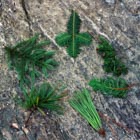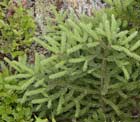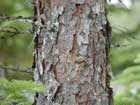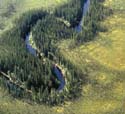
The flag of Labrador shows a black spruce twig. It is one of the few flags to bear the image of a conifer.

Mist rises from a black spruce forest on Kenai National Wildlife Refuge. These trees show the characteristic "club-headed" crown, with high branch density in the top meter or so of most trees [U.S. Fish and Wildlife Service, 2005.08.06].

Ontario's northern forest, growing around a rock in Killarney Provincial Park: clockwise from top are Abies balsamea, Tsuga canadensis, Thuja occidentalis, Pinus resinosa, Pinus strobus, and Picea mariana.

Foliage on a young sapling on the slopes of Mt. Katahdin, Maine. Note short needles, pale green new foliage [C.J. Earle, 2004.07].

Cones on a tree in a recently-burned muskeg, central Alaska [C.J. Earle, 1991.07].

Bark on a tree in Maine, about 25 cm diameter [C.J. Earle, 2003.07.14].

River in Alaska bordered by P. glauca forests surrounded by muskeg containing scattered small P. mariana [Dr. Linda B. Brubaker].

Picea mariana
(Miller) Britton Sterns, et Poggenburg 1888
Common names
Black spruce, bog spruce, swamp spruce, épinette noire (Canadian French) (Taylor 1993); zesegaandag [Ojibwe]; カナダトウヒ [Japanese].
Taxonomic notes
Synonymy (Taylor 1993):
- Abies mariana Miller 1768;
- Picea brevifolia Peck;
- P. mariana var. brevifolia (Peck) Rehder;
- P. nigra (Aiton) Link;
- Pinus nigra Aiton.
"To a limited extent, Picea mariana hybridizes with P. rubens, e.g., on disturbed sites in eastern Canada. Natural hybridization with P. glauca, though reported, remains unverified" (Taylor 1993).
Description
Trees to 25 m tall and 25 cm dbh (often much smaller, occurring as krummholz near the arctic treeline); "crown narrowly conic to spirelike. Bark gray-brown. Branches short and drooping, frequently layering; twigs not pendent, rather slender, yellow-brown, pubescent. Buds gray-brown, ca. 3 mm, apex acute. Leaves 0.6-1.5(2) cm, 4-angled in cross section, rigid, pale blue-green, glaucous, bearing stomates on all surfaces, apex mostly blunt-tipped. Seed cones 1.5-2.5(-3.5) cm [in cultivation rarely to 4.5 cm]; scales fan-shaped, broadest near apex, 8-12 × 8-12 mm, rigid, margin at apex irregularly toothed. 2n=24" (Taylor 1993). Cones fusiform, matt, dark purple ripening purple-brown (c.f. P. rubens ovoid, glossy, orange-brown).
Distribution and Ecology
Canada: all provinces and territories; France: St. Pierre and Miquelon; USA: Alaska, Connecticut, Maine, Massachusetts, Michigan, Minnesota, New Hampshire, New Jersey, New York, Pennsylvania, Rhode Island, Vermont, Wisconsin. Found at 0-1500 m elevation in muskegs, bogs, bottomlands, and relatively dry peatlands (Taylor 1993). See also Thompson et al. (1999). Hardy to Zone 2 (cold hardiness limit between -45.6°C and -40.0°C) (Bannister and Neuner 2001).
Distribution data from USGS (1999).
Remarkable Specimens
The national champion is 50 cm dbh, height 24 m, crown spread 6 m, located in Taylor County, Wisconsin (American Forests 1996). Vladimir Dinets (e-mail, 2003.10.18) reports "some unusually tall stands can be seen in eastern Labrador. I measured (by shadow comparison) a tree near Muskrat Falls (Goose Bay area) to be appr. 30 m tall."
The oldest known living specimen, 598 years, was documented in a tree-ring chronology covering the period 1046-2003 (fully crossdated), collected in far western Nunavut by Gordon Jacoby and colleagues (doi.org/10.25921/kpe9-5c53).
Ethnobotany
Although it is a small tree, vast tracts of it are currently being logged in Canada, primarily for pulp but also for timber (for example, the chopsticks provided at fast-food restaurants in the Far East are often P. mariana). Once (as of 2017) it has served as the U.S. Capitol Christmas tree.
Observations
Readily encountered in its native habitat throughout Canada, Alaska, and northern Minnesota, Wisconsin, Michigan and Maine. I was particularly interested by its occurrence near the summit of Mt. Katahdin in Maine, where it forms an alpine krummholz shrub, with trees only a few decimeters tall bearing cones. This is the only place I have seen it form alpine (rather than arctic) krummholz.
Remarks
The epithet is ancient and its derivation is not entirely clear, but various sources dating to the 16th and 17th centuries (HERE is an example from 1601) refer to "Abies marina" or "Abies mariana" ("Picea" is generally absent in literature of this age) or to the "Newfoundland spruce," so it evidently is the "maritime spruce," still abundant in Canada's maritime provinces.
Black spruce is the provincial tree of Newfoundland (Taylor 1993), and appears on the flag of Labrador.
Citations
American Forests 1996. The 1996-1997 National Register of Big Trees. Washington, DC: American Forests.
Britton, N. L., E. E. Sterns, and J. F. Poggenburg. 1888. Preliminary catalogue of Anthophyta and Pteridophyta reported as growing spontaneously within one hundred miles of New York City. New York: Torrey Botanical Club (p. 71).
This page co-edited with Michael P. Frankis, 1998.12.
See also
British Columbia Ministry of Forests. [no date]. The Ecology of the Boreal White and Black Spruce Zone, accessed 2009.03.25 (PDF file).
Burns and Honkala (1990).
Elwes and Henry 1906-1913 at the Biodiversity Heritage Library (as P. nigra). This series of volumes, privately printed, provides some of the most engaging descriptions of conifers ever published. Although they only treat species cultivated in the U.K. and Ireland, and the taxonomy is a bit dated, still these accounts are thorough, treating such topics as species description, range, varieties, exceptionally old or tall specimens, remarkable trees, and cultivation. Despite being over a century old, they are generally accurate, and are illustrated with some remarkable photographs and lithographs.
Girardin, M.-P., J. C. Tardif, M. D. Flannigan and Y. Bergeron. 2006. Synoptic-scale atmospheric circulation and boreal Canada summer drought variability of the past three centuries. Journal of Climate 19(10):1922-1947.
Little and Pauley (1958).
Morgenstern and Farrar (1964).
Sargent (1898) provides an exceptionally detailed description of this species, with an excellent illustration.
The FEIS database.







